Principles of Business Communication: Report on Key Concepts
VerifiedAdded on 2020/06/04
|11
|2802
|476
Report
AI Summary
This report comprehensively examines the principles of business communication, encompassing negotiation strategies, presentation techniques, bespoke document creation, and information system development. Part 1 delves into the importance of negotiation in business, outlining different approaches like lose-lose, compromise, integrative (win-win), and distributive (win-lose), alongside essential negotiation tactics. Part 2 explores various presentation types, resources, methods, and best practices, including feedback collection. Part 3 focuses on bespoke documents, covering their characteristics, creation factors, legal requirements, and techniques for gaining approval. Finally, Part 4 discusses information system development stages, benefits, limitations, and legal considerations. The report provides a detailed analysis of each aspect, offering valuable insights into effective business communication practices and the importance of information systems in modern organizations.
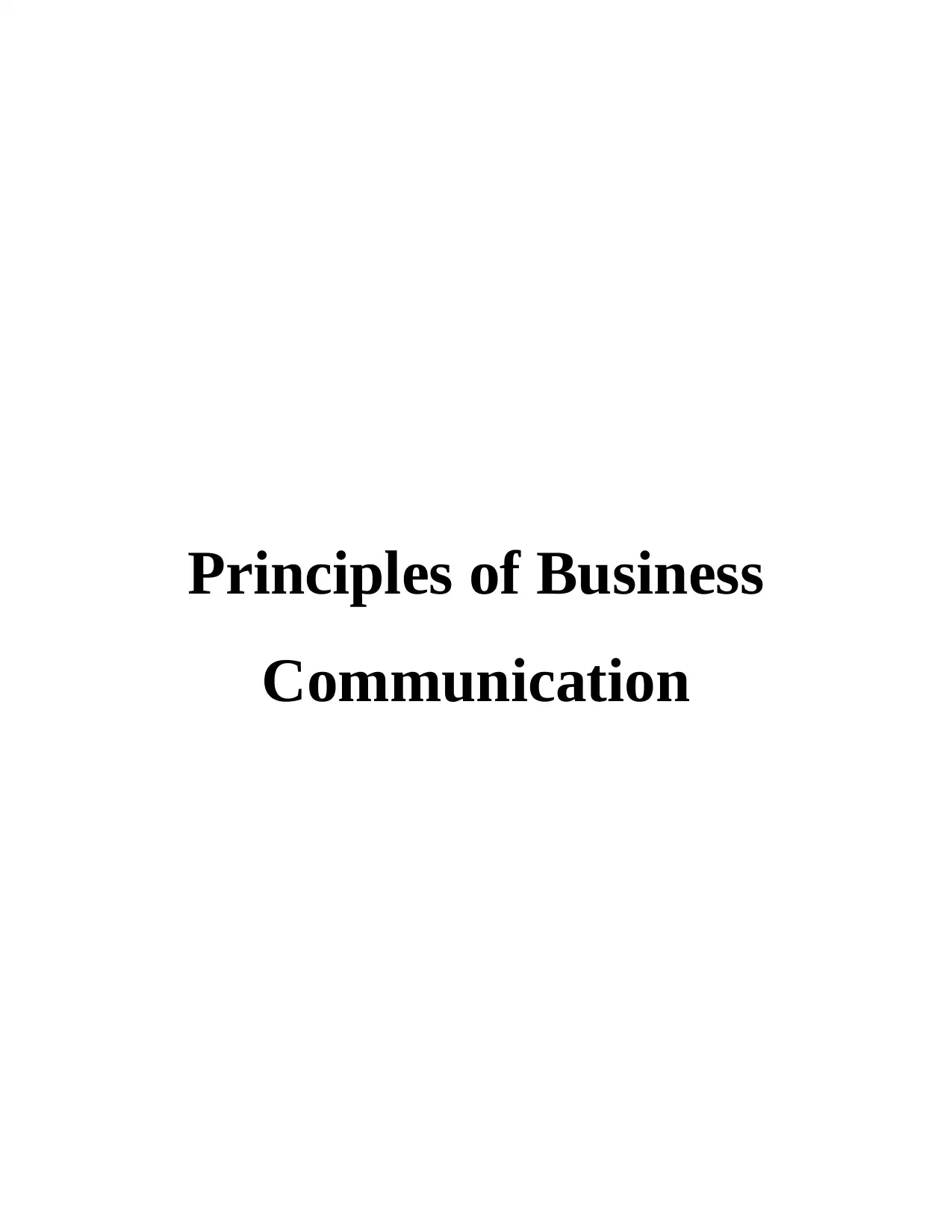
Principles of Business
Communication
Communication
Paraphrase This Document
Need a fresh take? Get an instant paraphrase of this document with our AI Paraphraser
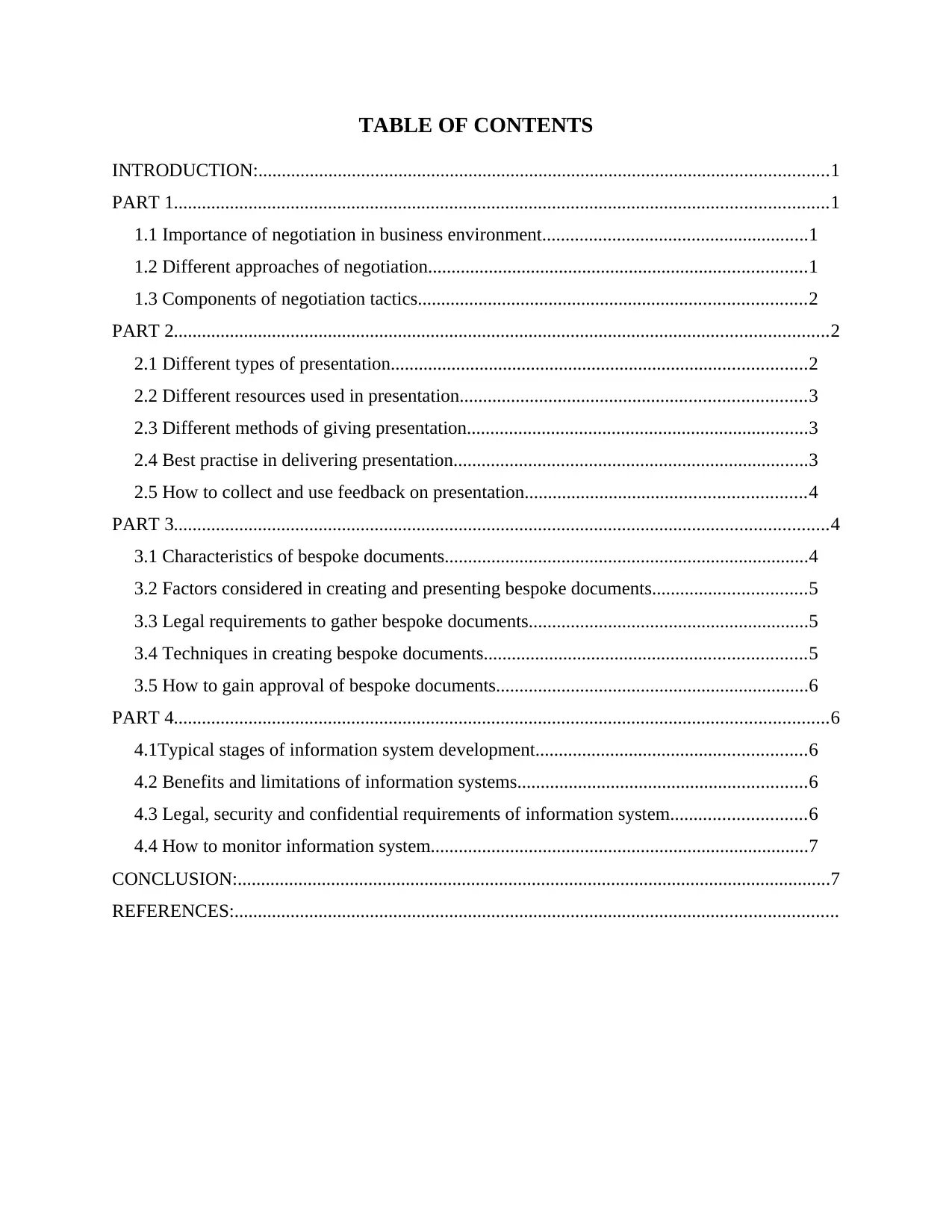
TABLE OF CONTENTS
INTRODUCTION:..........................................................................................................................1
PART 1............................................................................................................................................1
1.1 Importance of negotiation in business environment.........................................................1
1.2 Different approaches of negotiation.................................................................................1
1.3 Components of negotiation tactics...................................................................................2
PART 2............................................................................................................................................2
2.1 Different types of presentation.........................................................................................2
2.2 Different resources used in presentation..........................................................................3
2.3 Different methods of giving presentation.........................................................................3
2.4 Best practise in delivering presentation............................................................................3
2.5 How to collect and use feedback on presentation............................................................4
PART 3............................................................................................................................................4
3.1 Characteristics of bespoke documents..............................................................................4
3.2 Factors considered in creating and presenting bespoke documents.................................5
3.3 Legal requirements to gather bespoke documents............................................................5
3.4 Techniques in creating bespoke documents.....................................................................5
3.5 How to gain approval of bespoke documents...................................................................6
PART 4............................................................................................................................................6
4.1Typical stages of information system development..........................................................6
4.2 Benefits and limitations of information systems..............................................................6
4.3 Legal, security and confidential requirements of information system.............................6
4.4 How to monitor information system.................................................................................7
CONCLUSION:...............................................................................................................................7
REFERENCES:.................................................................................................................................
INTRODUCTION:..........................................................................................................................1
PART 1............................................................................................................................................1
1.1 Importance of negotiation in business environment.........................................................1
1.2 Different approaches of negotiation.................................................................................1
1.3 Components of negotiation tactics...................................................................................2
PART 2............................................................................................................................................2
2.1 Different types of presentation.........................................................................................2
2.2 Different resources used in presentation..........................................................................3
2.3 Different methods of giving presentation.........................................................................3
2.4 Best practise in delivering presentation............................................................................3
2.5 How to collect and use feedback on presentation............................................................4
PART 3............................................................................................................................................4
3.1 Characteristics of bespoke documents..............................................................................4
3.2 Factors considered in creating and presenting bespoke documents.................................5
3.3 Legal requirements to gather bespoke documents............................................................5
3.4 Techniques in creating bespoke documents.....................................................................5
3.5 How to gain approval of bespoke documents...................................................................6
PART 4............................................................................................................................................6
4.1Typical stages of information system development..........................................................6
4.2 Benefits and limitations of information systems..............................................................6
4.3 Legal, security and confidential requirements of information system.............................6
4.4 How to monitor information system.................................................................................7
CONCLUSION:...............................................................................................................................7
REFERENCES:.................................................................................................................................
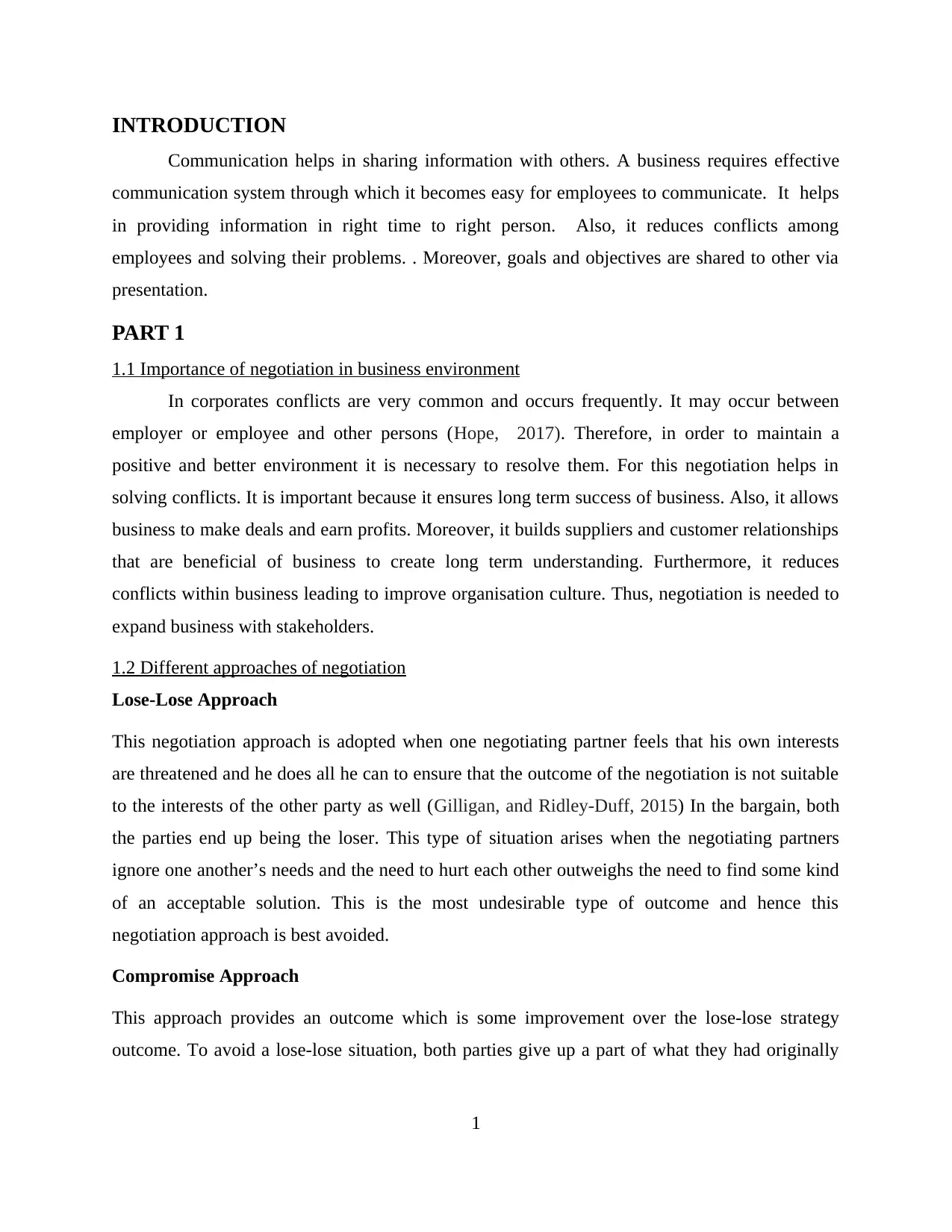
INTRODUCTION
Communication helps in sharing information with others. A business requires effective
communication system through which it becomes easy for employees to communicate. It helps
in providing information in right time to right person. Also, it reduces conflicts among
employees and solving their problems. . Moreover, goals and objectives are shared to other via
presentation.
PART 1
1.1 Importance of negotiation in business environment
In corporates conflicts are very common and occurs frequently. It may occur between
employer or employee and other persons (Hope, 2017). Therefore, in order to maintain a
positive and better environment it is necessary to resolve them. For this negotiation helps in
solving conflicts. It is important because it ensures long term success of business. Also, it allows
business to make deals and earn profits. Moreover, it builds suppliers and customer relationships
that are beneficial of business to create long term understanding. Furthermore, it reduces
conflicts within business leading to improve organisation culture. Thus, negotiation is needed to
expand business with stakeholders.
1.2 Different approaches of negotiation
Lose-Lose Approach
This negotiation approach is adopted when one negotiating partner feels that his own interests
are threatened and he does all he can to ensure that the outcome of the negotiation is not suitable
to the interests of the other party as well (Gilligan, and Ridley-Duff, 2015) In the bargain, both
the parties end up being the loser. This type of situation arises when the negotiating partners
ignore one another’s needs and the need to hurt each other outweighs the need to find some kind
of an acceptable solution. This is the most undesirable type of outcome and hence this
negotiation approach is best avoided.
Compromise Approach
This approach provides an outcome which is some improvement over the lose-lose strategy
outcome. To avoid a lose-lose situation, both parties give up a part of what they had originally
1
Communication helps in sharing information with others. A business requires effective
communication system through which it becomes easy for employees to communicate. It helps
in providing information in right time to right person. Also, it reduces conflicts among
employees and solving their problems. . Moreover, goals and objectives are shared to other via
presentation.
PART 1
1.1 Importance of negotiation in business environment
In corporates conflicts are very common and occurs frequently. It may occur between
employer or employee and other persons (Hope, 2017). Therefore, in order to maintain a
positive and better environment it is necessary to resolve them. For this negotiation helps in
solving conflicts. It is important because it ensures long term success of business. Also, it allows
business to make deals and earn profits. Moreover, it builds suppliers and customer relationships
that are beneficial of business to create long term understanding. Furthermore, it reduces
conflicts within business leading to improve organisation culture. Thus, negotiation is needed to
expand business with stakeholders.
1.2 Different approaches of negotiation
Lose-Lose Approach
This negotiation approach is adopted when one negotiating partner feels that his own interests
are threatened and he does all he can to ensure that the outcome of the negotiation is not suitable
to the interests of the other party as well (Gilligan, and Ridley-Duff, 2015) In the bargain, both
the parties end up being the loser. This type of situation arises when the negotiating partners
ignore one another’s needs and the need to hurt each other outweighs the need to find some kind
of an acceptable solution. This is the most undesirable type of outcome and hence this
negotiation approach is best avoided.
Compromise Approach
This approach provides an outcome which is some improvement over the lose-lose strategy
outcome. To avoid a lose-lose situation, both parties give up a part of what they had originally
1
⊘ This is a preview!⊘
Do you want full access?
Subscribe today to unlock all pages.

Trusted by 1+ million students worldwide
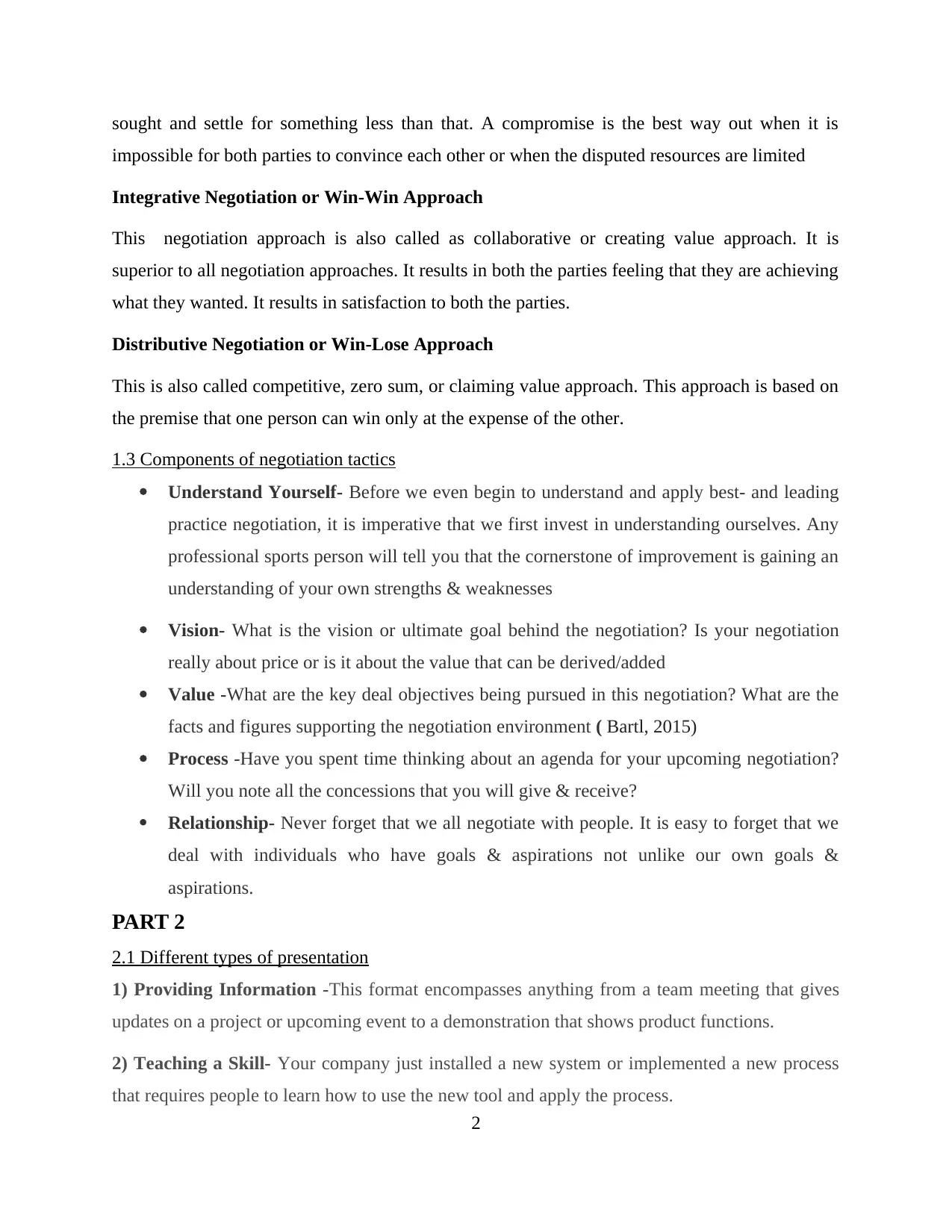
sought and settle for something less than that. A compromise is the best way out when it is
impossible for both parties to convince each other or when the disputed resources are limited
Integrative Negotiation or Win-Win Approach
This negotiation approach is also called as collaborative or creating value approach. It is
superior to all negotiation approaches. It results in both the parties feeling that they are achieving
what they wanted. It results in satisfaction to both the parties.
Distributive Negotiation or Win-Lose Approach
This is also called competitive, zero sum, or claiming value approach. This approach is based on
the premise that one person can win only at the expense of the other.
1.3 Components of negotiation tactics
Understand Yourself- Before we even begin to understand and apply best- and leading
practice negotiation, it is imperative that we first invest in understanding ourselves. Any
professional sports person will tell you that the cornerstone of improvement is gaining an
understanding of your own strengths & weaknesses
Vision- What is the vision or ultimate goal behind the negotiation? Is your negotiation
really about price or is it about the value that can be derived/added
Value -What are the key deal objectives being pursued in this negotiation? What are the
facts and figures supporting the negotiation environment ( Bartl, 2015)
Process -Have you spent time thinking about an agenda for your upcoming negotiation?
Will you note all the concessions that you will give & receive?
Relationship- Never forget that we all negotiate with people. It is easy to forget that we
deal with individuals who have goals & aspirations not unlike our own goals &
aspirations.
PART 2
2.1 Different types of presentation
1) Providing Information -This format encompasses anything from a team meeting that gives
updates on a project or upcoming event to a demonstration that shows product functions.
2) Teaching a Skill- Your company just installed a new system or implemented a new process
that requires people to learn how to use the new tool and apply the process.
2
impossible for both parties to convince each other or when the disputed resources are limited
Integrative Negotiation or Win-Win Approach
This negotiation approach is also called as collaborative or creating value approach. It is
superior to all negotiation approaches. It results in both the parties feeling that they are achieving
what they wanted. It results in satisfaction to both the parties.
Distributive Negotiation or Win-Lose Approach
This is also called competitive, zero sum, or claiming value approach. This approach is based on
the premise that one person can win only at the expense of the other.
1.3 Components of negotiation tactics
Understand Yourself- Before we even begin to understand and apply best- and leading
practice negotiation, it is imperative that we first invest in understanding ourselves. Any
professional sports person will tell you that the cornerstone of improvement is gaining an
understanding of your own strengths & weaknesses
Vision- What is the vision or ultimate goal behind the negotiation? Is your negotiation
really about price or is it about the value that can be derived/added
Value -What are the key deal objectives being pursued in this negotiation? What are the
facts and figures supporting the negotiation environment ( Bartl, 2015)
Process -Have you spent time thinking about an agenda for your upcoming negotiation?
Will you note all the concessions that you will give & receive?
Relationship- Never forget that we all negotiate with people. It is easy to forget that we
deal with individuals who have goals & aspirations not unlike our own goals &
aspirations.
PART 2
2.1 Different types of presentation
1) Providing Information -This format encompasses anything from a team meeting that gives
updates on a project or upcoming event to a demonstration that shows product functions.
2) Teaching a Skill- Your company just installed a new system or implemented a new process
that requires people to learn how to use the new tool and apply the process.
2
Paraphrase This Document
Need a fresh take? Get an instant paraphrase of this document with our AI Paraphraser
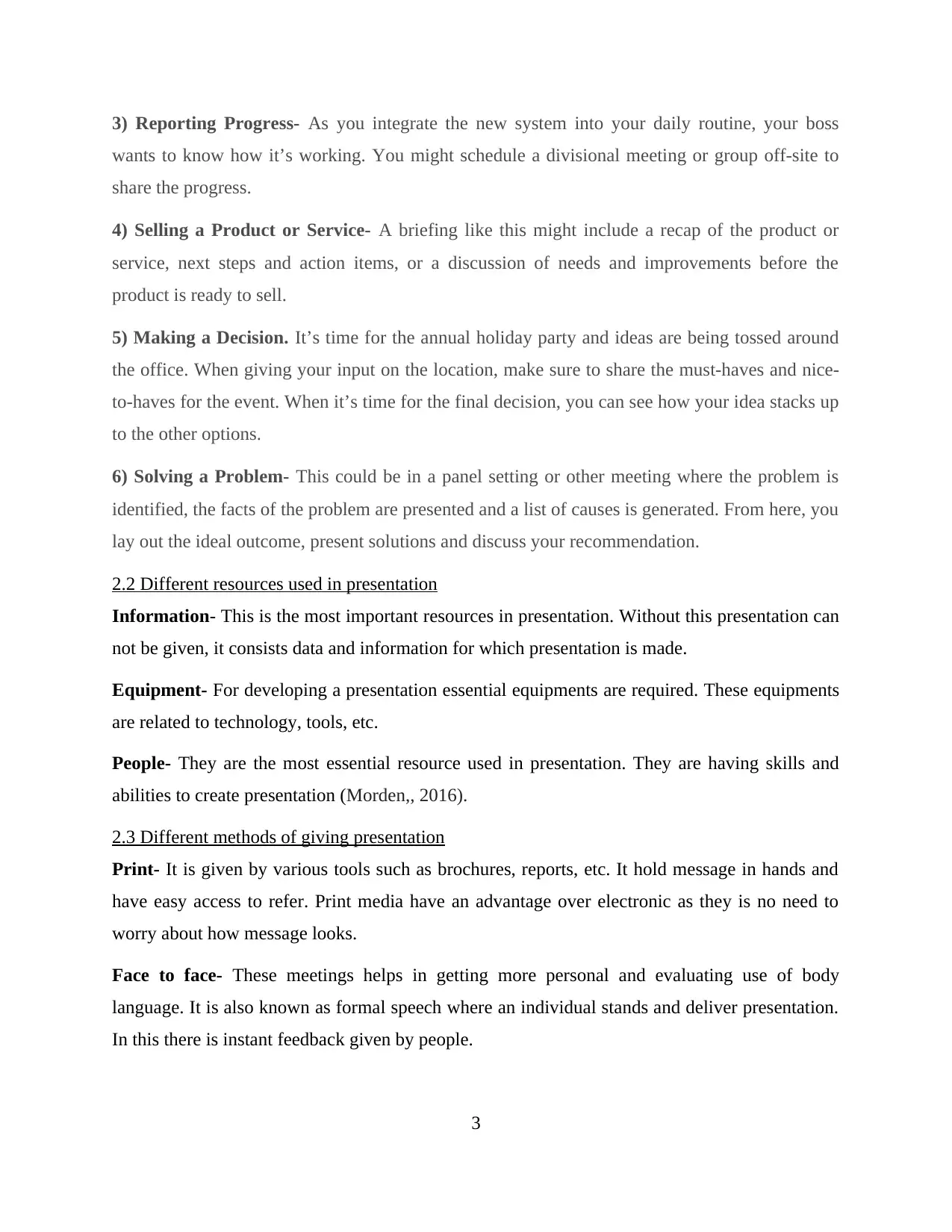
3) Reporting Progress- As you integrate the new system into your daily routine, your boss
wants to know how it’s working. You might schedule a divisional meeting or group off-site to
share the progress.
4) Selling a Product or Service- A briefing like this might include a recap of the product or
service, next steps and action items, or a discussion of needs and improvements before the
product is ready to sell.
5) Making a Decision. It’s time for the annual holiday party and ideas are being tossed around
the office. When giving your input on the location, make sure to share the must-haves and nice-
to-haves for the event. When it’s time for the final decision, you can see how your idea stacks up
to the other options.
6) Solving a Problem- This could be in a panel setting or other meeting where the problem is
identified, the facts of the problem are presented and a list of causes is generated. From here, you
lay out the ideal outcome, present solutions and discuss your recommendation.
2.2 Different resources used in presentation
Information- This is the most important resources in presentation. Without this presentation can
not be given, it consists data and information for which presentation is made.
Equipment- For developing a presentation essential equipments are required. These equipments
are related to technology, tools, etc.
People- They are the most essential resource used in presentation. They are having skills and
abilities to create presentation (Morden,, 2016).
2.3 Different methods of giving presentation
Print- It is given by various tools such as brochures, reports, etc. It hold message in hands and
have easy access to refer. Print media have an advantage over electronic as they is no need to
worry about how message looks.
Face to face- These meetings helps in getting more personal and evaluating use of body
language. It is also known as formal speech where an individual stands and deliver presentation.
In this there is instant feedback given by people.
3
wants to know how it’s working. You might schedule a divisional meeting or group off-site to
share the progress.
4) Selling a Product or Service- A briefing like this might include a recap of the product or
service, next steps and action items, or a discussion of needs and improvements before the
product is ready to sell.
5) Making a Decision. It’s time for the annual holiday party and ideas are being tossed around
the office. When giving your input on the location, make sure to share the must-haves and nice-
to-haves for the event. When it’s time for the final decision, you can see how your idea stacks up
to the other options.
6) Solving a Problem- This could be in a panel setting or other meeting where the problem is
identified, the facts of the problem are presented and a list of causes is generated. From here, you
lay out the ideal outcome, present solutions and discuss your recommendation.
2.2 Different resources used in presentation
Information- This is the most important resources in presentation. Without this presentation can
not be given, it consists data and information for which presentation is made.
Equipment- For developing a presentation essential equipments are required. These equipments
are related to technology, tools, etc.
People- They are the most essential resource used in presentation. They are having skills and
abilities to create presentation (Morden,, 2016).
2.3 Different methods of giving presentation
Print- It is given by various tools such as brochures, reports, etc. It hold message in hands and
have easy access to refer. Print media have an advantage over electronic as they is no need to
worry about how message looks.
Face to face- These meetings helps in getting more personal and evaluating use of body
language. It is also known as formal speech where an individual stands and deliver presentation.
In this there is instant feedback given by people.
3
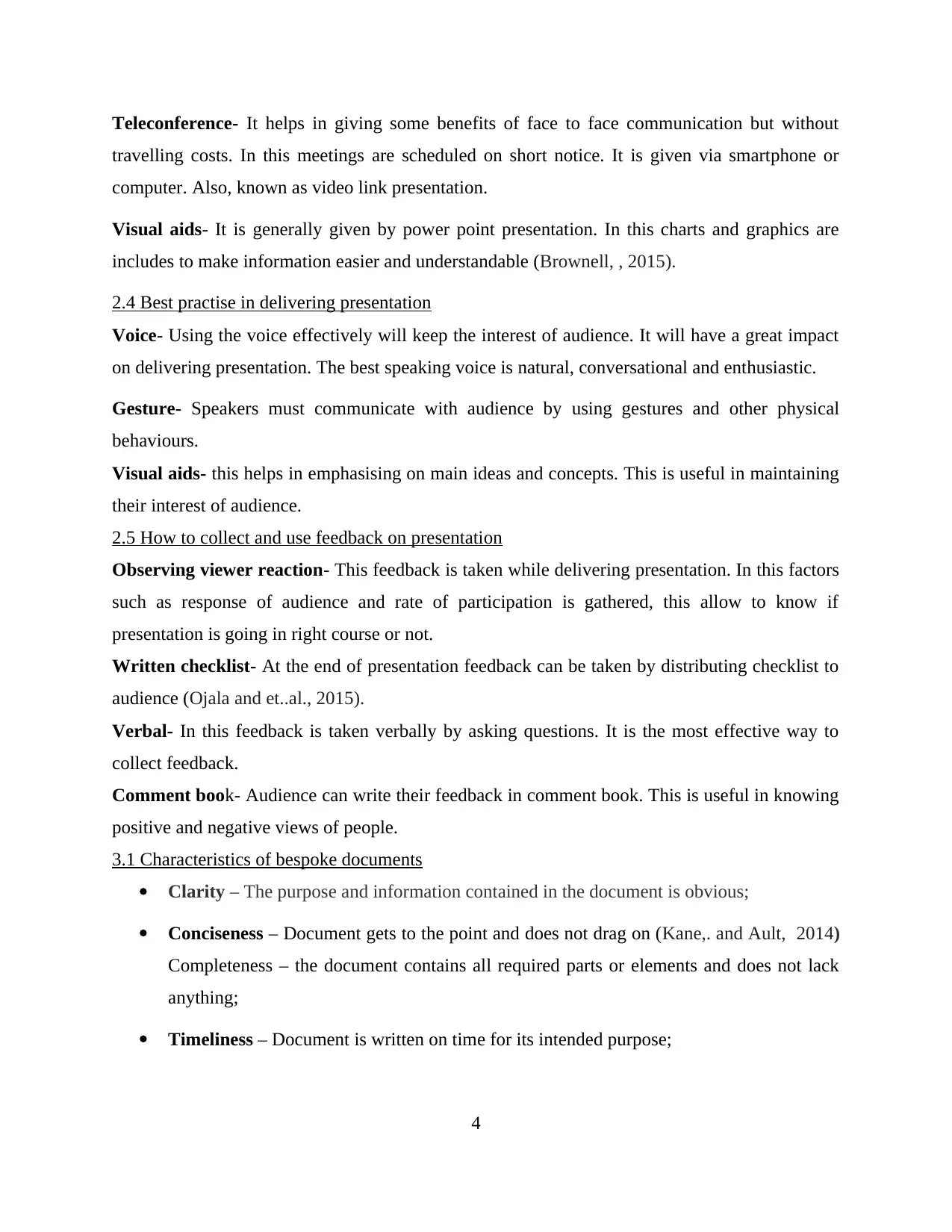
Teleconference- It helps in giving some benefits of face to face communication but without
travelling costs. In this meetings are scheduled on short notice. It is given via smartphone or
computer. Also, known as video link presentation.
Visual aids- It is generally given by power point presentation. In this charts and graphics are
includes to make information easier and understandable (Brownell, , 2015).
2.4 Best practise in delivering presentation
Voice- Using the voice effectively will keep the interest of audience. It will have a great impact
on delivering presentation. The best speaking voice is natural, conversational and enthusiastic.
Gesture- Speakers must communicate with audience by using gestures and other physical
behaviours.
Visual aids- this helps in emphasising on main ideas and concepts. This is useful in maintaining
their interest of audience.
2.5 How to collect and use feedback on presentation
Observing viewer reaction- This feedback is taken while delivering presentation. In this factors
such as response of audience and rate of participation is gathered, this allow to know if
presentation is going in right course or not.
Written checklist- At the end of presentation feedback can be taken by distributing checklist to
audience (Ojala and et..al., 2015).
Verbal- In this feedback is taken verbally by asking questions. It is the most effective way to
collect feedback.
Comment book- Audience can write their feedback in comment book. This is useful in knowing
positive and negative views of people.
3.1 Characteristics of bespoke documents
Clarity – The purpose and information contained in the document is obvious;
Conciseness – Document gets to the point and does not drag on (Kane,. and Ault, 2014)
Completeness – the document contains all required parts or elements and does not lack
anything;
Timeliness – Document is written on time for its intended purpose;
4
travelling costs. In this meetings are scheduled on short notice. It is given via smartphone or
computer. Also, known as video link presentation.
Visual aids- It is generally given by power point presentation. In this charts and graphics are
includes to make information easier and understandable (Brownell, , 2015).
2.4 Best practise in delivering presentation
Voice- Using the voice effectively will keep the interest of audience. It will have a great impact
on delivering presentation. The best speaking voice is natural, conversational and enthusiastic.
Gesture- Speakers must communicate with audience by using gestures and other physical
behaviours.
Visual aids- this helps in emphasising on main ideas and concepts. This is useful in maintaining
their interest of audience.
2.5 How to collect and use feedback on presentation
Observing viewer reaction- This feedback is taken while delivering presentation. In this factors
such as response of audience and rate of participation is gathered, this allow to know if
presentation is going in right course or not.
Written checklist- At the end of presentation feedback can be taken by distributing checklist to
audience (Ojala and et..al., 2015).
Verbal- In this feedback is taken verbally by asking questions. It is the most effective way to
collect feedback.
Comment book- Audience can write their feedback in comment book. This is useful in knowing
positive and negative views of people.
3.1 Characteristics of bespoke documents
Clarity – The purpose and information contained in the document is obvious;
Conciseness – Document gets to the point and does not drag on (Kane,. and Ault, 2014)
Completeness – the document contains all required parts or elements and does not lack
anything;
Timeliness – Document is written on time for its intended purpose;
4
⊘ This is a preview!⊘
Do you want full access?
Subscribe today to unlock all pages.

Trusted by 1+ million students worldwide
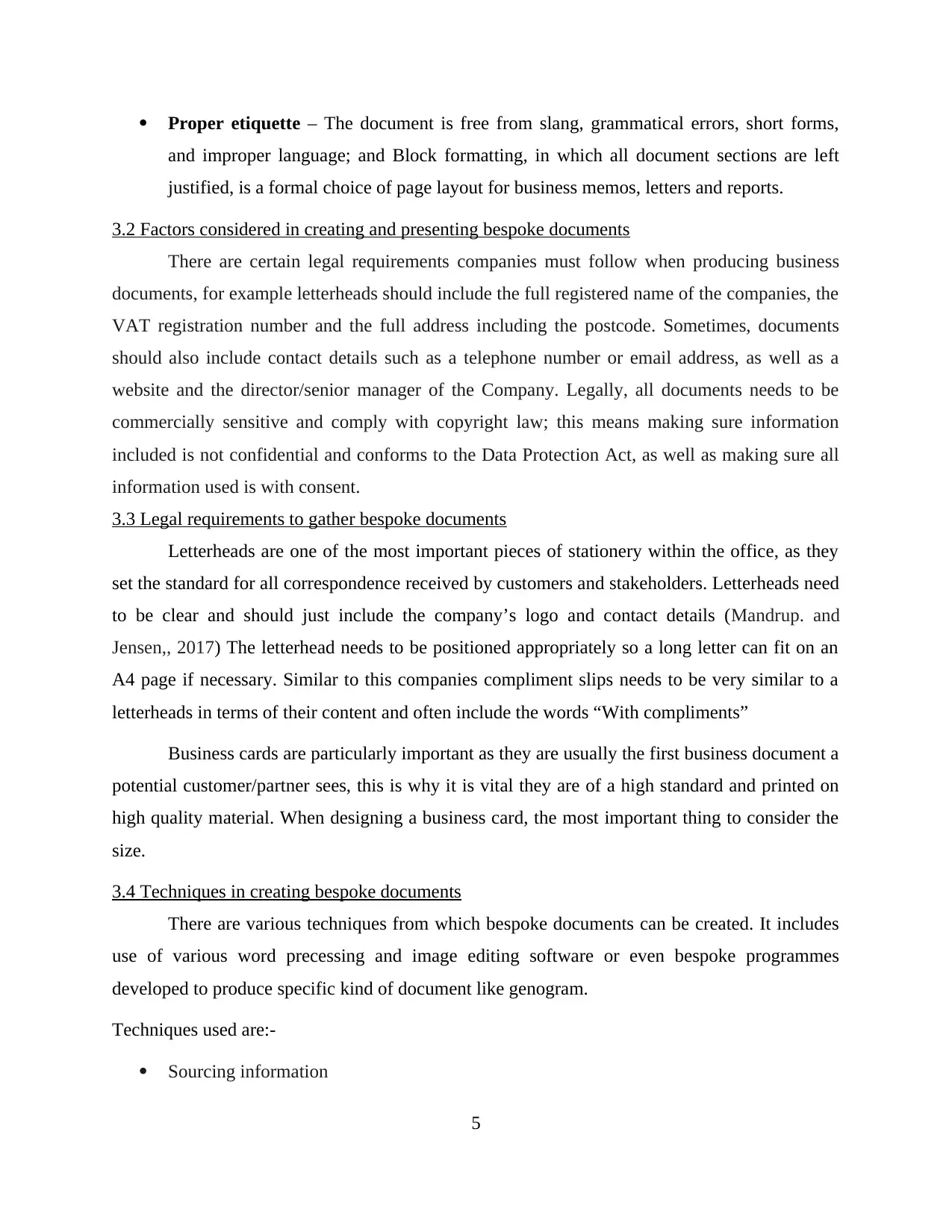
Proper etiquette – The document is free from slang, grammatical errors, short forms,
and improper language; and Block formatting, in which all document sections are left
justified, is a formal choice of page layout for business memos, letters and reports.
3.2 Factors considered in creating and presenting bespoke documents
There are certain legal requirements companies must follow when producing business
documents, for example letterheads should include the full registered name of the companies, the
VAT registration number and the full address including the postcode. Sometimes, documents
should also include contact details such as a telephone number or email address, as well as a
website and the director/senior manager of the Company. Legally, all documents needs to be
commercially sensitive and comply with copyright law; this means making sure information
included is not confidential and conforms to the Data Protection Act, as well as making sure all
information used is with consent.
3.3 Legal requirements to gather bespoke documents
Letterheads are one of the most important pieces of stationery within the office, as they
set the standard for all correspondence received by customers and stakeholders. Letterheads need
to be clear and should just include the company’s logo and contact details (Mandrup. and
Jensen,, 2017) The letterhead needs to be positioned appropriately so a long letter can fit on an
A4 page if necessary. Similar to this companies compliment slips needs to be very similar to a
letterheads in terms of their content and often include the words “With compliments”
Business cards are particularly important as they are usually the first business document a
potential customer/partner sees, this is why it is vital they are of a high standard and printed on
high quality material. When designing a business card, the most important thing to consider the
size.
3.4 Techniques in creating bespoke documents
There are various techniques from which bespoke documents can be created. It includes
use of various word precessing and image editing software or even bespoke programmes
developed to produce specific kind of document like genogram.
Techniques used are:-
Sourcing information
5
and improper language; and Block formatting, in which all document sections are left
justified, is a formal choice of page layout for business memos, letters and reports.
3.2 Factors considered in creating and presenting bespoke documents
There are certain legal requirements companies must follow when producing business
documents, for example letterheads should include the full registered name of the companies, the
VAT registration number and the full address including the postcode. Sometimes, documents
should also include contact details such as a telephone number or email address, as well as a
website and the director/senior manager of the Company. Legally, all documents needs to be
commercially sensitive and comply with copyright law; this means making sure information
included is not confidential and conforms to the Data Protection Act, as well as making sure all
information used is with consent.
3.3 Legal requirements to gather bespoke documents
Letterheads are one of the most important pieces of stationery within the office, as they
set the standard for all correspondence received by customers and stakeholders. Letterheads need
to be clear and should just include the company’s logo and contact details (Mandrup. and
Jensen,, 2017) The letterhead needs to be positioned appropriately so a long letter can fit on an
A4 page if necessary. Similar to this companies compliment slips needs to be very similar to a
letterheads in terms of their content and often include the words “With compliments”
Business cards are particularly important as they are usually the first business document a
potential customer/partner sees, this is why it is vital they are of a high standard and printed on
high quality material. When designing a business card, the most important thing to consider the
size.
3.4 Techniques in creating bespoke documents
There are various techniques from which bespoke documents can be created. It includes
use of various word precessing and image editing software or even bespoke programmes
developed to produce specific kind of document like genogram.
Techniques used are:-
Sourcing information
5
Paraphrase This Document
Need a fresh take? Get an instant paraphrase of this document with our AI Paraphraser
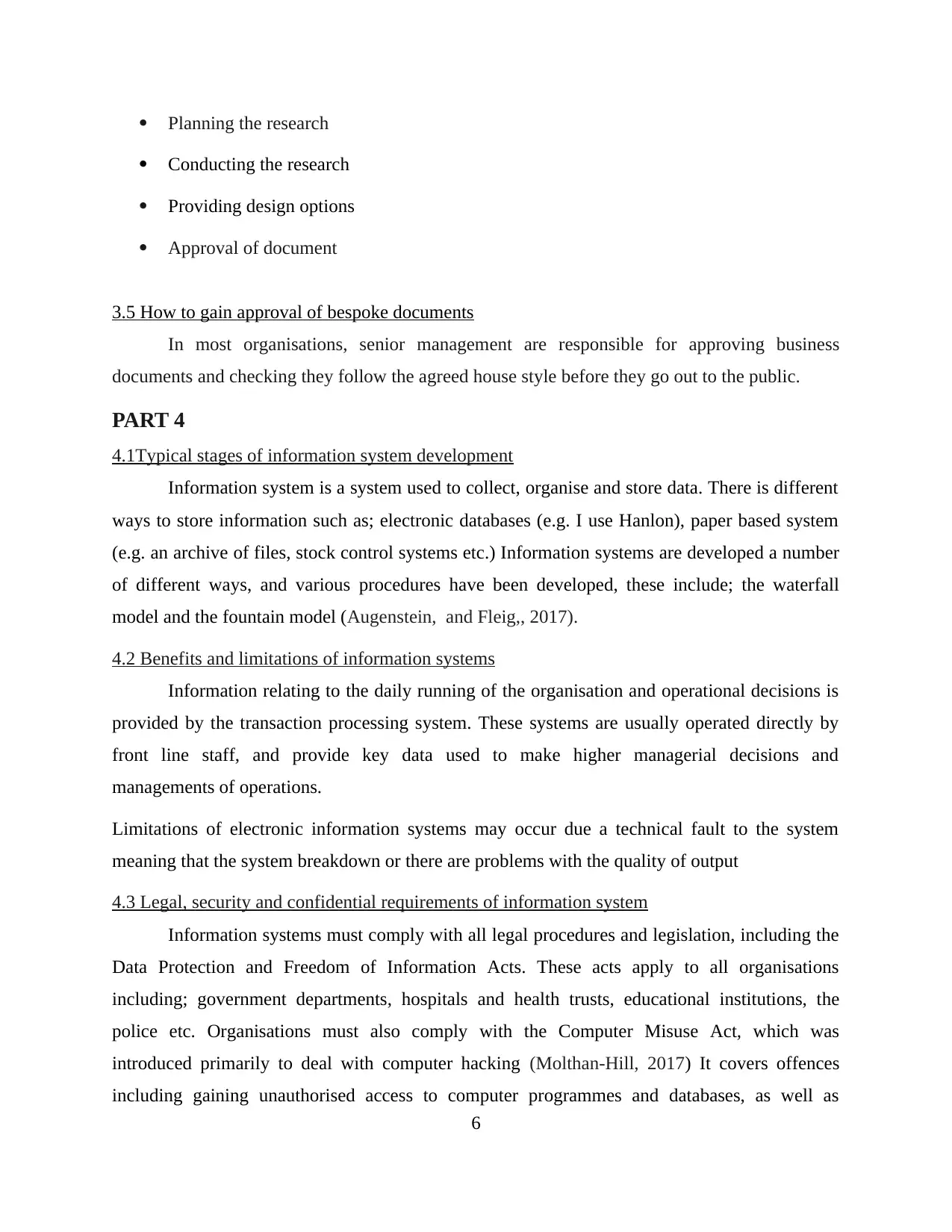
Planning the research
Conducting the research
Providing design options
Approval of document
3.5 How to gain approval of bespoke documents
In most organisations, senior management are responsible for approving business
documents and checking they follow the agreed house style before they go out to the public.
PART 4
4.1Typical stages of information system development
Information system is a system used to collect, organise and store data. There is different
ways to store information such as; electronic databases (e.g. I use Hanlon), paper based system
(e.g. an archive of files, stock control systems etc.) Information systems are developed a number
of different ways, and various procedures have been developed, these include; the waterfall
model and the fountain model (Augenstein, and Fleig,, 2017).
4.2 Benefits and limitations of information systems
Information relating to the daily running of the organisation and operational decisions is
provided by the transaction processing system. These systems are usually operated directly by
front line staff, and provide key data used to make higher managerial decisions and
managements of operations.
Limitations of electronic information systems may occur due a technical fault to the system
meaning that the system breakdown or there are problems with the quality of output
4.3 Legal, security and confidential requirements of information system
Information systems must comply with all legal procedures and legislation, including the
Data Protection and Freedom of Information Acts. These acts apply to all organisations
including; government departments, hospitals and health trusts, educational institutions, the
police etc. Organisations must also comply with the Computer Misuse Act, which was
introduced primarily to deal with computer hacking (Molthan-Hill, 2017) It covers offences
including gaining unauthorised access to computer programmes and databases, as well as
6
Conducting the research
Providing design options
Approval of document
3.5 How to gain approval of bespoke documents
In most organisations, senior management are responsible for approving business
documents and checking they follow the agreed house style before they go out to the public.
PART 4
4.1Typical stages of information system development
Information system is a system used to collect, organise and store data. There is different
ways to store information such as; electronic databases (e.g. I use Hanlon), paper based system
(e.g. an archive of files, stock control systems etc.) Information systems are developed a number
of different ways, and various procedures have been developed, these include; the waterfall
model and the fountain model (Augenstein, and Fleig,, 2017).
4.2 Benefits and limitations of information systems
Information relating to the daily running of the organisation and operational decisions is
provided by the transaction processing system. These systems are usually operated directly by
front line staff, and provide key data used to make higher managerial decisions and
managements of operations.
Limitations of electronic information systems may occur due a technical fault to the system
meaning that the system breakdown or there are problems with the quality of output
4.3 Legal, security and confidential requirements of information system
Information systems must comply with all legal procedures and legislation, including the
Data Protection and Freedom of Information Acts. These acts apply to all organisations
including; government departments, hospitals and health trusts, educational institutions, the
police etc. Organisations must also comply with the Computer Misuse Act, which was
introduced primarily to deal with computer hacking (Molthan-Hill, 2017) It covers offences
including gaining unauthorised access to computer programmes and databases, as well as
6
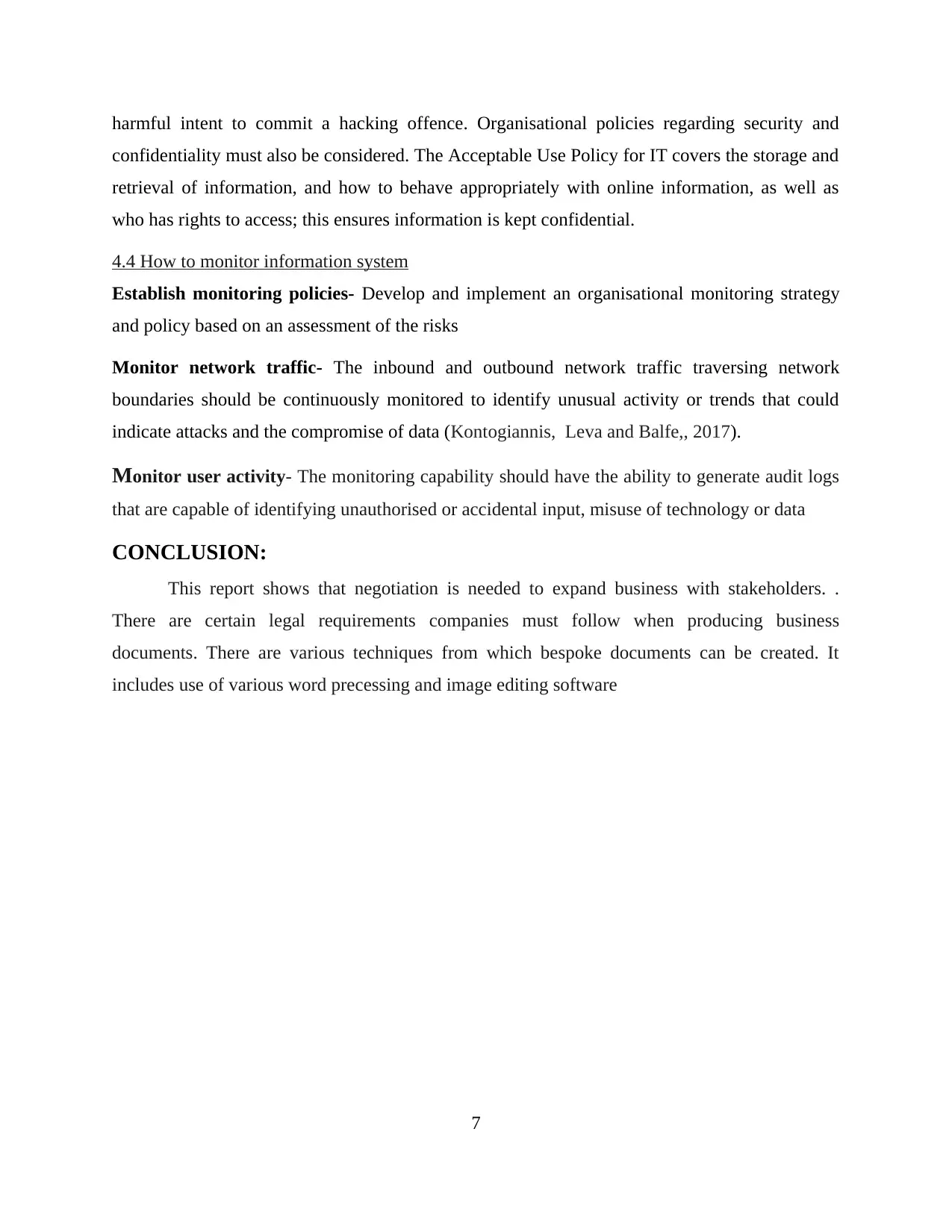
harmful intent to commit a hacking offence. Organisational policies regarding security and
confidentiality must also be considered. The Acceptable Use Policy for IT covers the storage and
retrieval of information, and how to behave appropriately with online information, as well as
who has rights to access; this ensures information is kept confidential.
4.4 How to monitor information system
Establish monitoring policies- Develop and implement an organisational monitoring strategy
and policy based on an assessment of the risks
Monitor network traffic- The inbound and outbound network traffic traversing network
boundaries should be continuously monitored to identify unusual activity or trends that could
indicate attacks and the compromise of data (Kontogiannis, Leva and Balfe,, 2017).
Monitor user activity- The monitoring capability should have the ability to generate audit logs
that are capable of identifying unauthorised or accidental input, misuse of technology or data
CONCLUSION:
This report shows that negotiation is needed to expand business with stakeholders. .
There are certain legal requirements companies must follow when producing business
documents. There are various techniques from which bespoke documents can be created. It
includes use of various word precessing and image editing software
7
confidentiality must also be considered. The Acceptable Use Policy for IT covers the storage and
retrieval of information, and how to behave appropriately with online information, as well as
who has rights to access; this ensures information is kept confidential.
4.4 How to monitor information system
Establish monitoring policies- Develop and implement an organisational monitoring strategy
and policy based on an assessment of the risks
Monitor network traffic- The inbound and outbound network traffic traversing network
boundaries should be continuously monitored to identify unusual activity or trends that could
indicate attacks and the compromise of data (Kontogiannis, Leva and Balfe,, 2017).
Monitor user activity- The monitoring capability should have the ability to generate audit logs
that are capable of identifying unauthorised or accidental input, misuse of technology or data
CONCLUSION:
This report shows that negotiation is needed to expand business with stakeholders. .
There are certain legal requirements companies must follow when producing business
documents. There are various techniques from which bespoke documents can be created. It
includes use of various word precessing and image editing software
7
⊘ This is a preview!⊘
Do you want full access?
Subscribe today to unlock all pages.

Trusted by 1+ million students worldwide
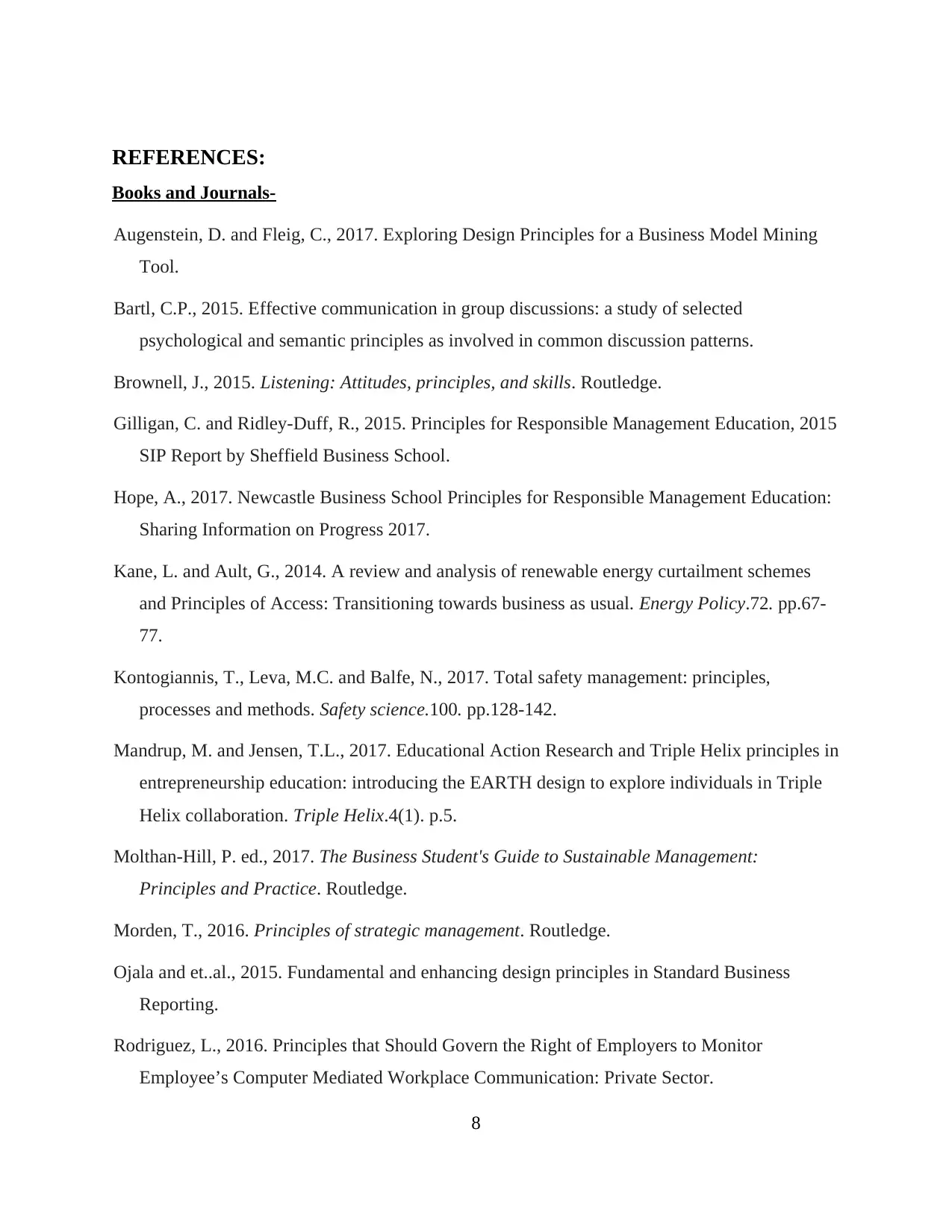
REFERENCES:
Books and Journals-
Augenstein, D. and Fleig, C., 2017. Exploring Design Principles for a Business Model Mining
Tool.
Bartl, C.P., 2015. Effective communication in group discussions: a study of selected
psychological and semantic principles as involved in common discussion patterns.
Brownell, J., 2015. Listening: Attitudes, principles, and skills. Routledge.
Gilligan, C. and Ridley-Duff, R., 2015. Principles for Responsible Management Education, 2015
SIP Report by Sheffield Business School.
Hope, A., 2017. Newcastle Business School Principles for Responsible Management Education:
Sharing Information on Progress 2017.
Kane, L. and Ault, G., 2014. A review and analysis of renewable energy curtailment schemes
and Principles of Access: Transitioning towards business as usual. Energy Policy.72. pp.67-
77.
Kontogiannis, T., Leva, M.C. and Balfe, N., 2017. Total safety management: principles,
processes and methods. Safety science.100. pp.128-142.
Mandrup, M. and Jensen, T.L., 2017. Educational Action Research and Triple Helix principles in
entrepreneurship education: introducing the EARTH design to explore individuals in Triple
Helix collaboration. Triple Helix.4(1). p.5.
Molthan-Hill, P. ed., 2017. The Business Student's Guide to Sustainable Management:
Principles and Practice. Routledge.
Morden, T., 2016. Principles of strategic management. Routledge.
Ojala and et..al., 2015. Fundamental and enhancing design principles in Standard Business
Reporting.
Rodriguez, L., 2016. Principles that Should Govern the Right of Employers to Monitor
Employee’s Computer Mediated Workplace Communication: Private Sector.
8
Books and Journals-
Augenstein, D. and Fleig, C., 2017. Exploring Design Principles for a Business Model Mining
Tool.
Bartl, C.P., 2015. Effective communication in group discussions: a study of selected
psychological and semantic principles as involved in common discussion patterns.
Brownell, J., 2015. Listening: Attitudes, principles, and skills. Routledge.
Gilligan, C. and Ridley-Duff, R., 2015. Principles for Responsible Management Education, 2015
SIP Report by Sheffield Business School.
Hope, A., 2017. Newcastle Business School Principles for Responsible Management Education:
Sharing Information on Progress 2017.
Kane, L. and Ault, G., 2014. A review and analysis of renewable energy curtailment schemes
and Principles of Access: Transitioning towards business as usual. Energy Policy.72. pp.67-
77.
Kontogiannis, T., Leva, M.C. and Balfe, N., 2017. Total safety management: principles,
processes and methods. Safety science.100. pp.128-142.
Mandrup, M. and Jensen, T.L., 2017. Educational Action Research and Triple Helix principles in
entrepreneurship education: introducing the EARTH design to explore individuals in Triple
Helix collaboration. Triple Helix.4(1). p.5.
Molthan-Hill, P. ed., 2017. The Business Student's Guide to Sustainable Management:
Principles and Practice. Routledge.
Morden, T., 2016. Principles of strategic management. Routledge.
Ojala and et..al., 2015. Fundamental and enhancing design principles in Standard Business
Reporting.
Rodriguez, L., 2016. Principles that Should Govern the Right of Employers to Monitor
Employee’s Computer Mediated Workplace Communication: Private Sector.
8
Paraphrase This Document
Need a fresh take? Get an instant paraphrase of this document with our AI Paraphraser

9
1 out of 11
Related Documents
Your All-in-One AI-Powered Toolkit for Academic Success.
+13062052269
info@desklib.com
Available 24*7 on WhatsApp / Email
![[object Object]](/_next/static/media/star-bottom.7253800d.svg)
Unlock your academic potential
Copyright © 2020–2025 A2Z Services. All Rights Reserved. Developed and managed by ZUCOL.





